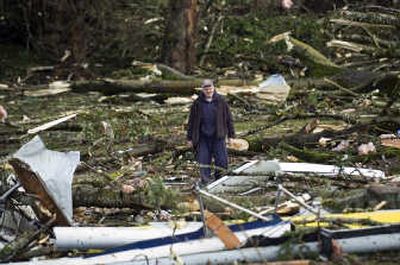Tornado rips through Vancouver, Wash., area

VANCOUVER, Wash. – A tornado downed power lines, uprooted trees, sent shopping carts flying into cars and demolished a rowing club Thursday in Vancouver.
There were no reports of injuries as the tornado cut through four miles from Vancouver Lake at the west edge of the town through the Hazel Dell area.
“It looks like we came through this pretty good,” said Jim Flaherty, spokesman for the Vancouver Fire Department.
Utility officials said about 800 people lost power.
“I saw it coming and thought, ‘Whatever that is, it’s scary,’ ” said Kym Calder, 47, who ran into a nearby church for shelter when she saw the funnel cloud ahead of her.
The wind ripped swatches of shingles off buildings and fences out of the ground. The trampoline in one Hazel Dell yard lifted into another, only to be pinned by a falling tree.
Lori Ratliff, 46, said she saw limbs and newspapers swirling in the air outside her second-story office and felt the building shake when the storm ripped the brick facade of the building.
While pockets of some neighborhoods were severely damaged, others were untouched.
Some of the storm’s heaviest damage was at the edge of Vancouver Lake, where it demolished the home of Vancouver Lake Crew.
More than 50 rowing shells, which cost thousands of dollars each, lay splintered on the shores. Two large trailers that served as the base for the nonprofit club lay twisted on the ground.
Dozens of volunteers helped pull chunks of rowing machines out of the bushes, and a canoe lay on the opposite shore.
It was a personal tragedy for the club’s founder, Bill Kalenius, who had just finished chemotherapy and radiation treatment during the holidays.
“He’s not supposed to be alive,” said Zeph Halsey, coach of the youth team. “This is why he’s alive.”
The group is almost entirely run by volunteers. One of the docks is an Eagle Scout project. And Kalenius had personally restored much of the donated equipment used by the group.
“He has dedicated his life to this,” his wife, Mary Kay Kalenius said. “It’s kept him afloat.”
The National Weather Service detected the tornado but couldn’t estimate its wind speed, said Steve Todd, chief meteorologist for the National Weather Service in Portland.
Todd said the region of southwest Washington and northwest Oregon sees only one or two tornadoes a year, most often in sparsely populated areas.
“We do see more of actually what we call funnel clouds,” he said. “Those are the same type of phenomenon, only they don’t touch down. As soon as they touch down a funnel cloud changes from a funnel cloud to a tornado.”
But, he said, Pacific Northwest tornadoes tend to be weaker than those of the Midwest.
On April 5, 1972, a tornado struck Vancouver, killing six people, injuring about 300 more and causing $3 million in damage. Among the injured were about 70 children from the Peter S. Ogden Elementary School, which was demolished.